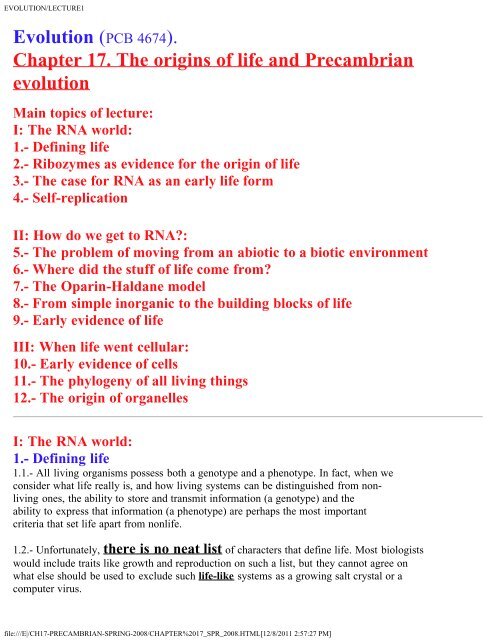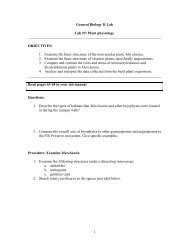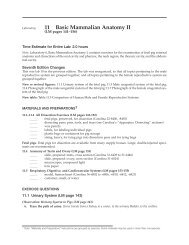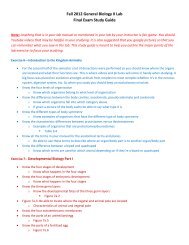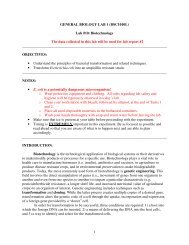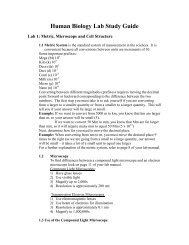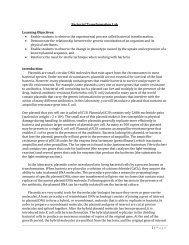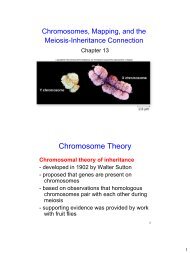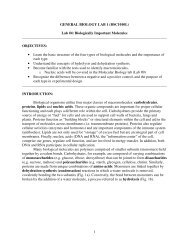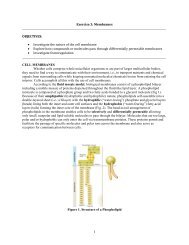Chapter 17. The origins of life and Precambrian evolution
Chapter 17. The origins of life and Precambrian evolution
Chapter 17. The origins of life and Precambrian evolution
Create successful ePaper yourself
Turn your PDF publications into a flip-book with our unique Google optimized e-Paper software.
EVOLUTION/LECTURE1<br />
Evolution (PCB 4674).<br />
<strong>Chapter</strong> <strong>17.</strong> <strong>The</strong> <strong>origins</strong> <strong>of</strong> <strong>life</strong> <strong>and</strong> <strong>Precambrian</strong><br />
<strong>evolution</strong><br />
Main topics <strong>of</strong> lecture:<br />
I: <strong>The</strong> RNA world:<br />
1.- Defining <strong>life</strong><br />
2.- Ribozymes as evidence for the origin <strong>of</strong> <strong>life</strong><br />
3.- <strong>The</strong> case for RNA as an early <strong>life</strong> form<br />
4.- Self-replication<br />
II: How do we get to RNA:<br />
5.- <strong>The</strong> problem <strong>of</strong> moving from an abiotic to a biotic environment<br />
6.- Where did the stuff <strong>of</strong> <strong>life</strong> come from<br />
7.- <strong>The</strong> Oparin-Haldane model<br />
8.- From simple inorganic to the building blocks <strong>of</strong> <strong>life</strong><br />
9.- Early evidence <strong>of</strong> <strong>life</strong><br />
III: When <strong>life</strong> went cellular:<br />
10.- Early evidence <strong>of</strong> cells<br />
11.- <strong>The</strong> phylogeny <strong>of</strong> all living things<br />
12.- <strong>The</strong> origin <strong>of</strong> organelles<br />
I: <strong>The</strong> RNA world:<br />
1.- Defining <strong>life</strong><br />
1.1.- All living organisms possess both a genotype <strong>and</strong> a phenotype. In fact, when we<br />
consider what <strong>life</strong> really is, <strong>and</strong> how living systems can be distinguished from nonliving<br />
ones, the ability to store <strong>and</strong> transmit information (a genotype) <strong>and</strong> the<br />
ability to express that information (a phenotype) are perhaps the most important<br />
criteria that set <strong>life</strong> apart from non<strong>life</strong>.<br />
1.2.- Unfortunately, there is no neat list <strong>of</strong> characters that define <strong>life</strong>. Most biologists<br />
would include traits like growth <strong>and</strong> reproduction on such a list, but they cannot agree on<br />
what else should be used to exclude such <strong>life</strong>-like systems as a growing salt crystal or a<br />
computer virus.<br />
file:///E|/CH17-PRECAMBRIAN-SPRING-2008/CHAPTER%2017_SPR_2008.HTML[12/8/2011 2:57:27 PM]
EVOLUTION/LECTURE1<br />
1.3.- However, many now agree that the ability to evolve is a crucial component <strong>of</strong> any<br />
definition <strong>of</strong> <strong>life</strong>. Evolution - or change over time - requires both the ability to record<br />
<strong>and</strong> make alterations in heritable information, <strong>and</strong> some way <strong>of</strong> distinguishing valuable<br />
changes from detrimental ones. <strong>The</strong> former is carried out by the genotype, while the<br />
later is carried our by a phenotype.<br />
2.- Ribozymes as evidence for RNA as an early <strong>life</strong> form<br />
2.1.- In the early 1980s, two teams <strong>of</strong> scientists independently discovered small<br />
enzymes that could break <strong>and</strong> reform the chemical bonds that hold strings <strong>of</strong><br />
nucleic acids intact. <strong>The</strong>se enzymes are able to catalyze the breakage <strong>of</strong> a phosphodiester<br />
bond <strong>of</strong> other nucleotide molecules (most <strong>of</strong> the times mRNA). <strong>The</strong>se enzymes are<br />
extremely important in the reactions <strong>of</strong> intron splicing, <strong>and</strong> splicing <strong>of</strong> precursors <strong>of</strong><br />
tRNAs.<br />
2.2.- However these enzymes were made not <strong>of</strong> protein, but <strong>of</strong> nucleic acid -<br />
specifically RNA. Until 1982, all known enzymes were proteins. RNA was <strong>of</strong>ten<br />
considered to be DNA's poor cousin, relegated to the task <strong>of</strong> shuttling biological<br />
information from DNA, where the information is stored, to proteins, which<br />
carry out all the work <strong>of</strong> the cell.<br />
2.3.- <strong>The</strong> finding <strong>of</strong> RNA enzymes, or ribozymes has changed how biologists view<br />
the operations <strong>of</strong> the cell. Perhaps more importantly, the existence <strong>of</strong> ribozymes<br />
has forever changed how biologists view the origin <strong>of</strong> the first cells - how they<br />
believe <strong>life</strong> originated <strong>and</strong> evolved on the early Earth.<br />
2.4.- Underst<strong>and</strong>ing the origin <strong>of</strong> <strong>life</strong> presents an enormous challenge for scientists.<br />
By our best estimate, <strong>life</strong> arose on the Earth approximately 4 billion years ago.<br />
No physical record <strong>of</strong> biological events has survived for this long. <strong>The</strong>refore<br />
the <strong>origins</strong> <strong>of</strong> <strong>life</strong> must be reconstructed using indirect evidence alone.<br />
2.5.- <strong>The</strong> solar system has an estimated age <strong>of</strong> 4.5 to 4.6 billions years. <strong>The</strong>refore<br />
the newborn Earth remained inhospitable for at least a few hundred million years.<br />
At first, it was simply too hot for <strong>life</strong>.<br />
2.6.- In the course <strong>of</strong> all the studies about the origin <strong>of</strong> <strong>life</strong>, a qu<strong>and</strong>ary quickly<br />
became apparent. Which substance did <strong>life</strong> acquire first, proteins or DNA Proteins<br />
can do all sort <strong>of</strong> complicated biological tasks, but there is no evidence that proteins<br />
can propagate themselves; they cannot transmit the information needed to replicate.<br />
DNA, on the other h<strong>and</strong>, is perfectly suited to store <strong>and</strong> transmit information by<br />
complementary base pairing, but it was not known to be able to perform any<br />
biological work. This chicken-<strong>and</strong>-egg problem <strong>of</strong> which came first was essentially<br />
resolved with the discovery <strong>of</strong> catalytic RNA. Since RNA has a capacity for information<br />
storage <strong>and</strong> transmission <strong>and</strong> the ability to perform biological work, we now<br />
think that it preceded both proteins <strong>and</strong> DNA in the march toward the origin <strong>of</strong> <strong>life</strong>.<br />
2.7.- <strong>The</strong> hypothesis <strong>of</strong> an RNA world is based on the realization, since the discovery<br />
file:///E|/CH17-PRECAMBRIAN-SPRING-2008/CHAPTER%2017_SPR_2008.HTML[12/8/2011 2:57:27 PM]
EVOLUTION/LECTURE1<br />
<strong>of</strong> ribozymes, that RNA can SIMULTANEOUSLY (!!!) possess both<br />
a genotype <strong>and</strong> a phenotype. <strong>The</strong> genotype is the primary sequence <strong>of</strong> nucleotides<br />
along the RNA. <strong>The</strong>se ribozymes can fold back on themselves many times to form<br />
a three-dimensional structure that have an active site that enables the RNA molecule<br />
to catalyze a chemical reaction on a substrate, as do protein enzymes (!!). This<br />
reactivity gives RNA its phenotype.<br />
2.8.- Dozens <strong>of</strong> naturally occurring ribozymes have now been discovered, <strong>and</strong> the phenotypes<br />
<strong>of</strong> all <strong>of</strong> them involve the formation <strong>and</strong> breaking <strong>of</strong> phosphodiester bonds in RNA or DNA.<br />
<strong>The</strong> general chemistry <strong>of</strong> these reactions is precisely what is needed to replicate nucleic<br />
acids. This observation gives support to the idea <strong>of</strong> a primordial RNA world, where RNA<br />
would be responsible for replicating itself in order to persist. If a molecule <strong>of</strong><br />
RNA could make a copy <strong>of</strong> itself while accommodating the possibility <strong>of</strong> mistakes, or<br />
mutations, then that molecule exhibit many <strong>of</strong> the characteristics <strong>of</strong> modern <strong>life</strong> <strong>and</strong><br />
could therefore be considered alive.<br />
3.- <strong>The</strong> case for RNA as an early <strong>life</strong> form<br />
3.1.- <strong>The</strong> RNA World hypothesis posits that <strong>and</strong> RNA-based living system evolved into<br />
one more like the <strong>life</strong> we see today, with DNA storing the biological information <strong>and</strong><br />
proteins manifesting this information. DNA is better suited as an information repository<br />
because it is chemically more stable than RNA. Especially when doubled str<strong>and</strong>ed, DNA<br />
can better withst<strong>and</strong> high temperatures <strong>and</strong> spontaneous degradation by acids or bases.<br />
3.2.- What evidence do we have that RNA is ancient <strong>The</strong> existence <strong>of</strong> catalytic RNA<br />
is certainly critical, but there are other indicators as well. <strong>The</strong> most highly conserved <strong>and</strong><br />
universal component <strong>of</strong> the information-processing machinery in cells, for example, is<br />
the apparatus for translation, the ribosome. This apparatus, while it incorporates proteins,<br />
is built on a frame made or RNA (rRNA), but they require RNA adaptors (tRNA) to carry<br />
out the task <strong>of</strong> protein synthesis. Furthermore, additional evidence indicates that it is the<br />
RNA portion <strong>of</strong> the ribosomes that actually carries out the catalytic steps in protein<br />
synthesis.<br />
3.3.- Another powerful argument for the antiquity <strong>of</strong> RNA is that the basic currency for<br />
biological energy, is ribonucleoside triphosphates such as ATP <strong>and</strong> GTP. <strong>The</strong>se<br />
molecules are involved in almost every energy-transfer operation <strong>of</strong> all cells,<br />
<strong>and</strong> are even components <strong>of</strong> electron-transfer c<strong>of</strong>actors.<br />
4.- Self-replication<br />
4.1.- A puzzle piece that we lack for the RNA world is the demonstration that RNA<br />
can copy itself. <strong>The</strong> as-yet-undiscovered "RNA-dependent RNA autoreplicase" remains<br />
a Holy Grail for <strong>origins</strong>-<strong>of</strong>-<strong>life</strong> research. Whether the RNA World used only one type<br />
<strong>of</strong> self replicating RNA or a suite <strong>of</strong> interacting RNAs, <strong>and</strong> RNA with a replicase phenotype<br />
would be necessary. <strong>The</strong> acquisition <strong>of</strong> the ability to self-replicate by a collection <strong>of</strong><br />
file:///E|/CH17-PRECAMBRIAN-SPRING-2008/CHAPTER%2017_SPR_2008.HTML[12/8/2011 2:57:27 PM]
EVOLUTION/LECTURE1<br />
organic molecules, such as RNA, is arguably the point at which non-living matter<br />
came to <strong>life</strong><br />
4.2.- <strong>The</strong> hypothesis that an RNA molecule could replicate itself, serving as a simple<br />
proto-organism, is testable. If the hypothesis is correct, then we should be able to<br />
make a self-replicating RNA molecule in the lab. This has not been achieved today,<br />
although a great <strong>of</strong> deal <strong>of</strong> research is currently being conducted in this field.<br />
II: How do we get to RNA:<br />
5.- <strong>The</strong> problem <strong>of</strong> moving from an abiotic to a biotic<br />
environment<br />
5.1.- <strong>The</strong> RNA world has many attractive features, <strong>and</strong> it solves the problem <strong>of</strong> having<br />
to propose the advent <strong>of</strong> proteins before DNA existed to encode them. But an RNA<br />
world come with troubles <strong>of</strong> its own. Some critics have claimed that it simply<br />
pushes the problem <strong>of</strong> the origin <strong>of</strong> self-replication one step back. <strong>The</strong> issue<br />
here is simple: How could any RNA sequences come into being from an abiotic<br />
environment.<br />
5.2.- <strong>The</strong> general consensus is that the RNA world was probably not the first<br />
self-replicating system. This is because the likelihood <strong>of</strong> making RNA abiotically<br />
is too minute (see below heading 8 <strong>of</strong> this lecture) . <strong>The</strong> first issue that we need to<br />
address is how information-containing biomolecules were made from simple<br />
inorganic compounds. Where did these molecules come from<br />
6.- Where did the stuff <strong>of</strong> <strong>life</strong> come from<br />
6.1.- On September 28, 1969 a meteor entered the Earth's atmosphere over the town <strong>of</strong><br />
Murchison, Australia. Soon after, scientists collected some <strong>of</strong> the meteorites <strong>and</strong> carefully<br />
brought them back to the laboratory for chemical analysis. To their astonishment, the<br />
analyses showed that organic compounds were present in the interior <strong>of</strong> the rocks.<br />
In particular, the amino acids glycine, alanine, glutamic acid, valine, <strong>and</strong> proline were<br />
found in significant concentrations. <strong>The</strong>se amino acids are among the ones used by<br />
modern organisms to make proteins.<br />
6.2.- <strong>The</strong> amino acids they found were racemic; that is, they included roughly equal<br />
proportion <strong>of</strong> the D- <strong>and</strong> L-stereoisomers. By contrast, biological amino acids<br />
are almost purely <strong>of</strong> the L-form, <strong>and</strong> thus terrestrial <strong>life</strong> could not be the source <strong>of</strong><br />
the compounds the researchers found in the meteorites<br />
6.3.- Why were the Murchison meteorites significant <strong>The</strong> biomolecules <strong>of</strong> <strong>life</strong>, as well<br />
as their likely precursors, all require the elements carbon, hydrogen, oxygen, nitrogen,<br />
sulfur, <strong>and</strong> phosphorus in large amounts. If these building blocks could have<br />
been synthesized on the primitive Earth, then presumably they would have been<br />
available for condensation into larger biomolecules. But if they could not have been<br />
file:///E|/CH17-PRECAMBRIAN-SPRING-2008/CHAPTER%2017_SPR_2008.HTML[12/8/2011 2:57:27 PM]
EVOLUTION/LECTURE1<br />
made on Earth, we would have to look to extraterrestrial sources, such as meteors,<br />
to account for their presence.<br />
6.4.- <strong>The</strong> problem with terrestrial sources is that, 4 billion years ago, the Earth's environment<br />
might not have been permissive for the synthesis <strong>of</strong> <strong>life</strong>'s building blocks. A<br />
key feature <strong>of</strong> the environment is whether it was primarily oxidizing, with high<br />
abundance <strong>of</strong> molecular oxygen, <strong>and</strong> carbon dioxide or primarily reducing with high<br />
concentrations <strong>of</strong> hydrogen, methane, <strong>and</strong> ammonia.<br />
6.5.- Some feel that geochemical evidence points to an atmosphere that would not be<br />
favorable for the generation <strong>of</strong> biologically important molecules. Thus, many have<br />
explored an alternative hypothesis that certain critical biochemicals were made elsewhere<br />
in the solar system <strong>and</strong> delivered to the Earth in meteorites. In fact the young Earth<br />
experienced heavy bombardment by meteors <strong>and</strong> comets<br />
7.- <strong>The</strong> Oparin-Haldane model<br />
7.1.- Originally, there was great hope that the Earth itself could provide the "right"<br />
stuff for prebiotic synthesis. In 1953, Stanley Miller built an apparatus that boiled<br />
water <strong>and</strong> circulated the hot vapor through an atmosphere <strong>of</strong> methane, ammonia,<br />
<strong>and</strong> hydrogen, past an electric spark, <strong>and</strong> finally through a cooling jacket that condensed<br />
the vapor <strong>and</strong> directed it back into the boiling flask (Fig. 14.A). Miller identified the<br />
amino acids glycine, alpha-alanine, <strong>and</strong> beta-alanine in the final boiling flask.<br />
Similar experiments conducted by other scientists have documented the formation <strong>of</strong><br />
a tremendous diversity <strong>of</strong> organic molecules.<br />
Figure 14.A.: Diagram <strong>of</strong> the apparatus Miller used to simulate<br />
the environmental conditions <strong>of</strong> a hypothetical reducing<br />
environment <strong>of</strong> early Earth<br />
file:///E|/CH17-PRECAMBRIAN-SPRING-2008/CHAPTER%2017_SPR_2008.HTML[12/8/2011 2:57:27 PM]
EVOLUTION/LECTURE1<br />
7.2.- Miller used methane, ammonia, <strong>and</strong> hydrogen as in the 1950s it was thought that<br />
the atmosphere <strong>of</strong> the young Earth was highly reducing. However, many atmospheric<br />
chemists now believe that Earth's early atmosphere was not so reducing, being dominated<br />
by Carbon Dioxide rather than methane, <strong>and</strong> molecular nitrogen rather than ammonia.<br />
7.3.- Reaching a consensus on the prebiotic environment is important, because an<br />
atmosphere dominated by carbon dioxide <strong>and</strong> molecular nitrogen appears to be<br />
much less conducive to the formation <strong>of</strong> certain organic molecules.<br />
7.4.- <strong>The</strong> view that the Earth possessed all the necessary ingredients for the origin<br />
<strong>of</strong> <strong>life</strong> is perhaps the most thoroughly investigated hypothesis <strong>and</strong> holds great<br />
appeal for many scientists even today. This opinion dates back to the efforts <strong>of</strong><br />
A. Oparin <strong>and</strong> J.B.S. Haldane, working in the first half <strong>of</strong> the 20th century. This<br />
scenario is <strong>of</strong>ten referred to as the Oparin-Haldane model<br />
8.- From simple inorganic to the building blocks <strong>of</strong> <strong>life</strong><br />
8.1.- Previously, we saw the ease with which amino acids can be made from simple<br />
inorganic like methane, ammonia, <strong>and</strong> hydrogen. What about nucleotides. A<br />
second monumental achievement in <strong>origins</strong>-<strong>of</strong>-<strong>life</strong> research was the demonstration<br />
by Juan Oró (1961) that the nitrogenous base adenine (a purine) could be readily<br />
made from a thermodynamically favorable reaction involving only ammonia<br />
file:///E|/CH17-PRECAMBRIAN-SPRING-2008/CHAPTER%2017_SPR_2008.HTML[12/8/2011 2:57:27 PM]
EVOLUTION/LECTURE1<br />
<strong>and</strong> hydrogen cyanide (HCN).<br />
8.2.- Other chemists have had similar results for other purine bases. Pyrimidines<br />
are slightly more difficult to construct abiotically, but chemists have had some<br />
successes. Finally, the ribose sugars that form nucleotides can, at least under<br />
the right environmental conditions, be derived from a cascade <strong>of</strong> condensation<br />
reactions that begin only from formaldehyde.<br />
8.3.- A major obstacle that has plagued biochemists for decades is the origin <strong>of</strong><br />
chirality, or h<strong>and</strong>edness. Living systems today use only one stereoisomer, or<br />
mirror-image form, <strong>of</strong> the amino acid in their proteins, <strong>and</strong> the same is<br />
true <strong>of</strong> nucleotides. In many <strong>of</strong> the chemical synthesis described by adherents<br />
to the Oparin-Haldane model, both mirror images <strong>of</strong> the building blocks are<br />
made in roughly equal quantities, <strong>and</strong> it is difficult to devise mechanisms that<br />
produce only one or the other. Exacerbating this problem is the fact that one<br />
mirror-image would inhibit the polymerization <strong>of</strong> the other during<br />
any type <strong>of</strong> polymer self-replication<br />
8.4.- Furthermore, as is the case with sugar formation, not only does the sugar<br />
that we see today in nucleic acids (ribose) constitute a very small percentage <strong>of</strong><br />
all the sugar products <strong>of</strong> formaldehyde condensation, but there also exist multiple<br />
equally probable ways that the nitrogenous bases could be attached to the sugar.<br />
Each <strong>of</strong> these combinations produces a different nucleotide isomer than that<br />
used by contemporary RNA. To make matters worse, each building block<br />
(nucleotide) needs to be activated, or chemically charged before it can be incorporated<br />
into a polymer. Activation requires a pre-existing source <strong>of</strong> chemical energy.<br />
Without cell membranes to concentrate this energy (as ATP), it is challenging<br />
to underst<strong>and</strong> how building blocks became activated in the RNA World.<br />
All these problems stress what we already mentioned in heading 5.2. <strong>of</strong> this<br />
lecture: "the likelihood <strong>of</strong> making RNA abiotically is too minute"<br />
8.5.- Many researchers now think that the RNA was likely to have been a<br />
later stage in an <strong>evolution</strong>ary lineage that derived from simpler genetic<br />
systems made <strong>of</strong> other kinds <strong>of</strong> polymers such as hybrids between peptides<br />
<strong>and</strong> nucleic acids, or composed <strong>of</strong> pyranose instead <strong>of</strong> ribose.<br />
9.- Earliest evidence <strong>of</strong> <strong>life</strong><br />
9.1.- <strong>The</strong> oldest known sedimentary rocks to contain evidence suggesting that <strong>life</strong><br />
was already established on Earth by 3.85 billion years ago. <strong>The</strong> rocks are from<br />
Akilia Isl<strong>and</strong> <strong>and</strong> Isua, both in Greenl<strong>and</strong> <strong>and</strong> they contain apatite crystals. <strong>The</strong> high<br />
ratios <strong>of</strong> 12 C to 13 C found in these crystals indicate that the apatite has an biological<br />
origin.<br />
III: When <strong>life</strong> went cellular:<br />
file:///E|/CH17-PRECAMBRIAN-SPRING-2008/CHAPTER%2017_SPR_2008.HTML[12/8/2011 2:57:27 PM]
EVOLUTION/LECTURE1<br />
10.- Early evidence <strong>of</strong> cells<br />
10.1.- Once self-replicating systems evolved on the Earth, at least one <strong>of</strong> them adapted<br />
to the use <strong>of</strong> DNA to store heritable information <strong>and</strong> to the use <strong>of</strong> proteins to express<br />
that information. This system eventually gave rise to all lineages <strong>of</strong> <strong>life</strong> on the planet<br />
today: We draw this conclusion because all <strong>life</strong> forms (except viruses) use DNA <strong>and</strong><br />
proteins. In fact, all modern organisms use them in the same way; the same<br />
20 amino acids <strong>and</strong> the same basic structure <strong>of</strong> the genetic code have been found<br />
in all creatures studied to date. Thus, we apply the principle <strong>of</strong> parsimony to infer<br />
that all organisms share common ancestor<br />
10.2.- Because another shared feature <strong>of</strong> all extant <strong>life</strong> is the existence <strong>of</strong> cells, we<br />
also infer that the common ancestor was a cellular form. <strong>The</strong> advantages <strong>of</strong><br />
cellular membranes, as well as internal organellar membranes would have been<br />
enormous. Cells allow for compartmentalization. This allowed <strong>life</strong> to accumulate<br />
its necessary constituents in much higher concentration than they are found free<br />
in solution. Cells allowed genotypes <strong>and</strong> phenotypes to be linked<br />
10.3.- <strong>The</strong> first place we might look in trying to identify the ancestral cells is the fossil<br />
record. <strong>The</strong> oldest fossils definitively established as those <strong>of</strong> living organisms are<br />
3.465 billion years old (Fig. 14.15). <strong>The</strong>se fossils come from Western Australia. they<br />
show simple cells growing in short filaments<br />
Figure 14.15.: <strong>The</strong> oldest known fossils <strong>of</strong> living organisms. <strong>The</strong><br />
fossils show filaments composed <strong>of</strong> individual cells lined up like<br />
beads <strong>of</strong> a string<br />
file:///E|/CH17-PRECAMBRIAN-SPRING-2008/CHAPTER%2017_SPR_2008.HTML[12/8/2011 2:57:27 PM]
EVOLUTION/LECTURE1<br />
11.- <strong>The</strong> phylogeny <strong>of</strong> all living things<br />
11.1.- Another way to study the ancestral lineage is to reconstruct the phylogeny <strong>of</strong> all<br />
living things. A universal phylogeny should allow us to infer additional characteristics<br />
<strong>of</strong> the earliest <strong>life</strong> forms.<br />
11.2.- <strong>The</strong> challenge in using sequence data (nucleotide sequences from DNA) to estimate<br />
the <strong>evolution</strong>ary tree for all living things is to find a gene that shows recognizable sequence<br />
similarities even between species that are as distantly related as Escherichia coli <strong>and</strong><br />
Homo sapiens. We need a gene that is present in all organisms, <strong>and</strong> that encodes a product<br />
whose function is essential <strong>and</strong> thus subject to strong stabilizing selection. Additionally the<br />
function <strong>of</strong> the gene must have remained the same in all organisms. One gene that meet all<br />
the criteria for use in reconstructing the universal phylogeny is the gene that codes for<br />
the small-subunit ribosomal RNA. Ribosomes are the machines responsible for translation.<br />
Translation is so vital, <strong>and</strong> organisms are under such strong natural selection to maintain<br />
it, that the ribosomal RNAs <strong>of</strong> humans <strong>and</strong> their intestinal bacteria show recognizable<br />
similarities in nucleotide sequence, even though humans <strong>and</strong> bacteria last shared a common<br />
ancestor billions <strong>of</strong> years ago.<br />
11.3.- An estimated <strong>of</strong> the universal phylogeny, based on sequences <strong>of</strong> the small-subunit<br />
file:///E|/CH17-PRECAMBRIAN-SPRING-2008/CHAPTER%2017_SPR_2008.HTML[12/8/2011 2:57:27 PM]
EVOLUTION/LECTURE1<br />
rRNA, appears in Figure 14.16.<br />
Figure 14.16.: An estimate <strong>of</strong> the phylogeny <strong>of</strong> all living organisms.<br />
This tree is based on the analysis <strong>of</strong> nucleotide sequences <strong>of</strong><br />
small-subunit rRNAs<br />
<strong>The</strong> whole-<strong>life</strong> rRNA phylogeny has prompted a dramatic revision <strong>of</strong> our traditional view<br />
<strong>of</strong> the organization <strong>of</strong> <strong>life</strong>, because it reveals that the five-kingdom system <strong>of</strong><br />
classification [i.e., Plants, Animals, Fungi, Protists (this is the taxomic kingdom that<br />
comprises a variety <strong>of</strong> unicellular <strong>and</strong> some simple multinuclear <strong>and</strong> multicellular<br />
eukaryotic organisms, they include some algae, the protozoans, <strong>and</strong> multicellular<br />
or multinucleate autotrophs), <strong>and</strong> Monera (this is taxonomic kingdom that comprises<br />
the prokaryotes (bacteria <strong>and</strong> cyanobacteria))] bears only a limited resemblance to actual<br />
<strong>evolution</strong>ary relationships.<br />
11.4.- <strong>The</strong> prokaryotes, for example, which are all grouped in the kingdom Monera in<br />
the traditional classification, occupy two <strong>of</strong> the three main branches <strong>of</strong> the rRNA<br />
phylogeny. One <strong>of</strong> these two branches, the Bacteria, includes virtually all <strong>of</strong> the wellknown<br />
prokaryotes. <strong>The</strong> other prokaryote branch, the Archaea, is not well known.<br />
Many <strong>of</strong> the Archaea live in physiologically harsh environments like hot springs, <strong>and</strong> are<br />
difficult to grow in culture. <strong>The</strong>y are also known as the Archebacteria<br />
11.5.- As the phylogeny in Figure 14.16 shows, the archebacteria are in fact more closely<br />
related to the eukaryotes than they are to the true bacteria. <strong>The</strong> most inclusive taxonomic<br />
units in the new classification are three domains corresponding to the three main branches<br />
file:///E|/CH17-PRECAMBRIAN-SPRING-2008/CHAPTER%2017_SPR_2008.HTML[12/8/2011 2:57:27 PM]
EVOLUTION/LECTURE1<br />
on the tree <strong>of</strong> <strong>life</strong>: the Bacteria, the Archaea, <strong>and</strong> the Eucarya. It has been proposed<br />
that the these three branches are designated as kingdoms.<br />
11.6.- <strong>The</strong> universal rRNA phylogeny demonstrates, however, that the Animals, Plants,<br />
<strong>and</strong> Fungi, "the kingdoms" that have absorbed most <strong>of</strong> the attention <strong>of</strong> <strong>evolution</strong>ary<br />
biologists, are mere twigs on the tip <strong>of</strong> one branch <strong>of</strong> the tree <strong>of</strong> <strong>life</strong>. <strong>The</strong> multicellular,<br />
macroscopic organisms in these three "kingdoms" are newcomers on the <strong>evolution</strong>ary<br />
scene, with a relatively recent common ancestor<br />
12.- <strong>The</strong> origin <strong>of</strong> organelles<br />
12.1.- Evolution from the common ancestors to the extant Bacteria <strong>and</strong> Archaea<br />
appears to have been a process <strong>of</strong> gradual refinement. <strong>The</strong> Eucarya, on the other<br />
h<strong>and</strong>, are dramatically different. Among other things, eukaryotes have complex<br />
cells containing a variety <strong>of</strong> organelles, <strong>and</strong> dramatically more complicated genomes,<br />
in which the coding regions <strong>of</strong> genes are frequently interrupted by intervening<br />
sequences <strong>of</strong> noncoding DNA (introns). In addition many eukaryotes are<br />
multicellular, with differentiated cells <strong>and</strong> tissues. We will only consider one <strong>of</strong> these<br />
problems here, the <strong>evolution</strong>ary origin <strong>of</strong> organelles.<br />
12.2.- <strong>The</strong> organelles whose <strong>evolution</strong> is best understood are mitochondrial <strong>and</strong><br />
chloroplasts. Most Eucarya have mitochondrial <strong>and</strong> many also have chloroplasts,<br />
but some early-branching eukaryotes (Giardia lamblia) have neither. Thus<br />
mitochondria <strong>and</strong> chloroplasts do not appear to be defining characteristics <strong>of</strong> the<br />
Eucarya; instead, they arose within the eukaryotic branch <strong>of</strong> the tree <strong>of</strong> <strong>life</strong>.<br />
12.3.- Superficially, mitochondria <strong>and</strong> chloroplasts resemble simple bacteria. With<br />
the discovery that mitochondria <strong>and</strong> chloroplasts have their own chromosomes,<br />
<strong>and</strong> that these chromosomes are small circular DNA molecules similar to<br />
those <strong>of</strong> bacteria, biologists began to take seriously an old idea that had been<br />
dismissed by all but a persistent few. This idea is that mitochondria <strong>and</strong> chloroplasts<br />
originated as bacteria that lived as internal symbionts <strong>of</strong> early eukaryotic cells.<br />
12.4.- <strong>The</strong> definitive test <strong>of</strong> this hypothesis was to sequence genes from mitochondrial<br />
<strong>and</strong> chloroplasts, such as the genes for the small-subunit ribosomal RNA, then determine<br />
their position on the universal phylogeny. If the organelles arose via symbiosis, then<br />
their rRNA genes should branch from within the Bacteria; if, instead, the organelles<br />
arose independently within the Eucarya, then their rRNA gene should branch from<br />
within the Eucarya. <strong>The</strong> results are in, <strong>and</strong> they prove that the endosymbiosis theory is<br />
correct (Fig. 14.24). Mitochondria are closely related to the protobacteria,<br />
previously called purple bacteria. Chloroplasts are cyanobacteria<br />
Figure 14.24.: An estimate <strong>of</strong> the universal phylogeny, showing<br />
the locations <strong>of</strong> the mitochondrial <strong>and</strong> chloroplasts. <strong>The</strong><br />
file:///E|/CH17-PRECAMBRIAN-SPRING-2008/CHAPTER%2017_SPR_2008.HTML[12/8/2011 2:57:27 PM]
EVOLUTION/LECTURE1<br />
mitochondria are represented by that <strong>of</strong> Zea mays.<br />
file:///E|/CH17-PRECAMBRIAN-SPRING-2008/CHAPTER%2017_SPR_2008.HTML[12/8/2011 2:57:27 PM]


